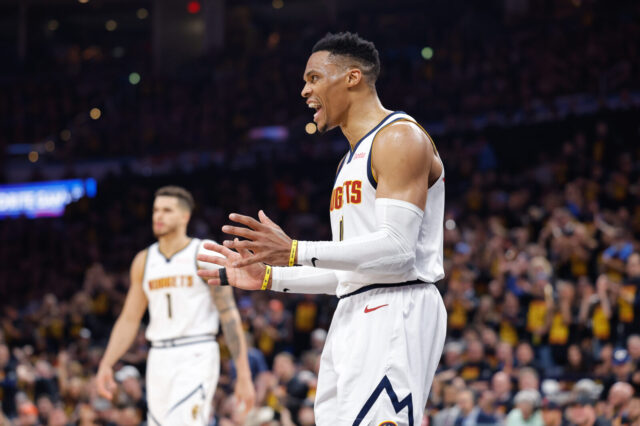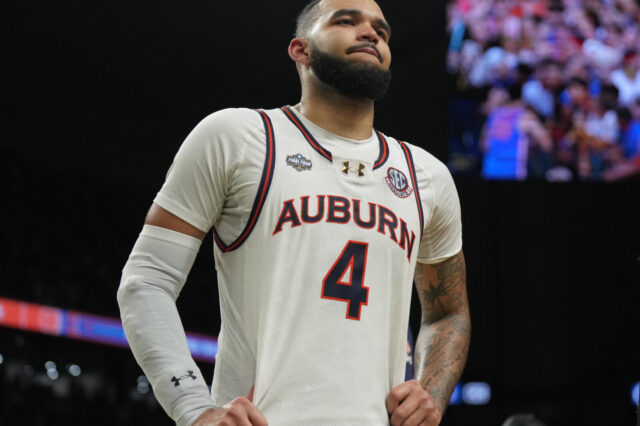Yesterday, CBSsports.com’s Zach Harper wrote a very interesting article about each team’s best rim protector, providing some advanced statistical analysis to support his arguments. For the Denver Nuggets, he chose Nikola Jokic. This came as a surprise to the Nuggets faithful who have labeled Jokic the offensive talent and Jusuf Nurkic the defensive specialist. However, upon closer look, Jokic might actually be the better defender. At least for right now.
Blocked shots
Part of the reason that so many Nuggets fans consider Nurkic the better defender is because of the counting stats, namely blocked shots. Nurkic led the team in blocks per game despite playing the fewest minutes per game of the team's rotation bigs. He blocked more than twice as many shots as the team's second leading shot blocker on a per-36 minute basis. Jokic, on the other hand, had just six more total blocked shots than Nurkic this year despite playing more than three times as many minutes.
| Blocks per game | Blocks per 36 minutes | |
| Nikola Jokic | 0.6 | 1.0 |
| Jusuf Nurkic | 1.4 | 2.9 |
But while blocked shots create some of the game's best highlights, they are not always a very good indicator of a player's rim protection. Some players over-pursue blocked shots or routinely get lured out of the paint trying to contest shots at the expense of giving up offensive rebounds and/or easy dropoffs. In other cases, over pursuing block shots can lead to more fouls and opponent free throws. That's not to say that blocked shots are bad. A blocked shot prevents a scoring opportunity and that is inherently good. Rather, blocked shots are just a part of rim protection, and a surprisingly modest part at that.
Physicality, Persona, and Intimidation
Another reason that Nurkic is thought of as the better rim protection is because Nurkic is by far the more imposing physical specimen. Jokic has a thin frame and a very light-hearted way about himself on the court. Even when his is dominating games he looks calm and effortless. Nurkic on the hand, has an edge to him. He loves to get physical and taunt his opponent after a big play. He has several high-profile scuffles with elite low-post talents like DeMarcus Cousins and Marc Gasol. Jokic’s nickname is “the Joker” while Nurkic’s nickname is “The Beast.” Both names point to their on-curt demeanor.
Advanced Stats
Yet despite their reputations, Jokic was definitively more productive as a defensive presence this season by nearly every advanced metric including on/off defensive rating, opponent points in the paint, second chance points, and defensive field goal percentage from 0-6 ft.
| On DRTG | Off DRTG | Opp DFG% 0-6 ft | Opp PITP | Opp 2nd pts | |
| Nikola Jokic | 105.3 | 111.7 | 53.2% | 39.6* | 10.1* |
| Jusuf Nurkic | 107.1 | 109.3 | 59.1% | 44.0* | 14.1* |
*per 100 possessions
On/Off numbers are not the best metrics for measuring individual players impact, especially defensively, since a player that plays more frequently with more talented lineups will benefit just from playing alongside better players. Nonetheless, the on/off numbers provide the first piece of evidence that Jokic is the better defender. It is also noteworthy that Jokic had the best individual DRTG of every player on the Nuggets roster by the end of the year.
Opponent points in the paint, second chance points, and defensive field goal percentage are much more telling. In all three metrics, Jokic rates better than Nurkic. Opponents shoot worse at the rim, score fewer points in the paint, and grab fewer second chance points with Jokic on the court than they do with Nurkic on the court. Especially surprising is that with Jokic on the court, opponents shoot fewer three pointers but more shots from 15 feet or further than they do with Nurkic on the court which is evidence that Jokic either takes away the easiest shots in the game or he lures opponents into more inefficient shots, or both. More on that below.
Fouls matter
Another important difference between Nurkic and Jokic is their foul rates. Nurkic averaged six fouls per 36 minutes, meaning that on average, if he were to play starter's minutes, he would foul out. That foul rate was the 5th highest in the entire NBA for players to play in at least 25 games. Jokic, on the other hand, averaged just 4.3 fouls per 36 minutes.
The contrast in foul rates is indicative of one of the key differences between the way that Jokic and Nurkic approach defense. Jokic is not very strong, mobile, or quick and he seems to know that about himself. Rather than pursue big time defensive plays like blocked shots, Jokic instead cuts off angles and takes away opponent's easiest scoring options.
This differs quite a bit from Nurkic's approach. Nurkic routinely goes after the big play, whether it's a steal or a blocked shot. While Jokic seems content to allow opponents to take bad shots, Nurkic actively tries to take away all shots.
In this clip below, pay close attention to the angle that Jokic takes after Zaza Pachulia catches the ball. Jokic was prepared for the pick and roll and cut off the ball-handlers driving lane but left Zaza open from the free throw line. Rather than attack Zaza on the roll, Jokic sprints at an angle that allows him to cut off a shot at the rim. Zaza sees that Jokic has conceded a six-foot pull up and settles for it, while Jokic is in position to contest but not in position to actually get the blocked shot.
The Nuggets would settle for Zaza taking six-foot floaters all game. Jokic prevented the worst scenario – which would have been a shot at the rim – and instead forced Zaza into a low efficiency shot with poor position for an offensive rebound.
Contrast Jokic’s approach in that clip with Nurkic’s approach in the clip below. Nurkic’s first responsibility on this possession is to try and contain Andrew Wiggins on the pick and roll but Nurkic is a bit too careless as he approaches the ball-handler and gets caught crossing his legs on defense.
This content is no longer available.
This allows Wiggins to snake the screen and attack the middle of the floor with momentum. Still, Nurkic could've recovered by taking a better angle and forcing Wiggins to shoot over him. Instead, Nurkic seems more interested in blocking the shot and takes a straight line at Wiggins, clobbering him on the head. (If you think Nurkic did NOT foul Wiggins, take a look at this screen shot.)
In the next clip, watch how Jokic comes all the way out to the three point line to take away Cory Joseph's pull up three-pointer. However, as soon as Joseph crosses the arc, Jokic takes a huge step backward. This is Jokic conceding the mid-range shot – albeit with a hand in the shooter's face – at the trade-off of preventing Joseph from beating him off the dribble or dropping the ball off to the rolling big man.
Contrast that play to the play by Nurkic below in which he goes after a block but instead gives up a foul for an and-1. Nurkic seems to allow the ball handler deep position because he wants the best chance at a highlight play but rather than merely contest Tony Allen, he swings for a huge block and instead gives up an and-1 to end the quarter.
Lastly, both players are late to defensive rotations a fair amount which isn't surprising for two players who each have fewer than 2000 total minutes played in the NBA. However, the difference between how the two players recover is quite noticeable. In the three clips below, notice how Jokic is a step slow to cut off the angle or rotate to the driving opponent yet is able to recover and contest the shot without really trying to block it. Jokic makes himself as tall as possible and forces the defender to shoot over him but is sure to avoid the foul.
Contrast that once again with Nurkic who is late to rotate and recover in the two clips below, but compounds those mistakes by creating silly fouls.
The clips might seem like cherry picking the best and worst moments of each player but they are actually fairly representative of the two player's defensive styles. Jokic rarely makes highlight defensive plays but almost always takes away the opponents easiest option. And when he is late on a rotation, he recovers with his hands high and forfeits trying to make any play on the ball. Nurkic routinely invites players to enter his zone on defense so that he can actively contest them. And when he is late on a rotation, he becomes even riskier on defense, going for steals and blocked shots.
Nurkic still has an incredible amount of upside on the defensive end. There were moments in each of the last two seasons that Nurkic's defensive presence strongly discouraged opponents from even testing him at the rim. However, his discipline and footwork have a long way to go. It's possible that some of Nurkic's issues last season were due in part to his slow recovery from offseason knee surgery. However, many of Nurkic's advanced stats in 2014-15, such as foul rate, opponent points in the paint, and defensive field goal percentage, were still worse than what Jokic's numbers were last year.
One of my favorite comparison’s for Nurkic is Steven Adams. Like Nurkic, Adams is a physical freak of nature. Both Nurkic and Adams are among the strongest and most imposing centers in the league. In his rookie season, Adams averaged six fouls per 36 minutes, identical to Nurkic last season. Adams’ foul rate dropped in his sophomore season and fell again in his third season all the way down to just four fouls per 36 minutes. Like Jokic, Adams has learned that forcing opponents into tough shots is almost always better than blocking shots. He’s also learned that his strength and physicality is best served after the shot goes up, rather than before.
Nurkic is surprisingly nimble for a guy his size and like Jokic, Nurkic he has incredibly quick hands on defense. Nurkic's size probably makes his defensive upside quite a bit higher than Jokic's but in order for Nurkic to come anywhere close to becoming the defensive player that Steven Adams is, he'll have to learn from both Adams and Jokic that defense is as much a game of chess as it is a battle of wills.
For now, the Nuggets best rim protector is Nikola Jokic.
This content is no longer available.


